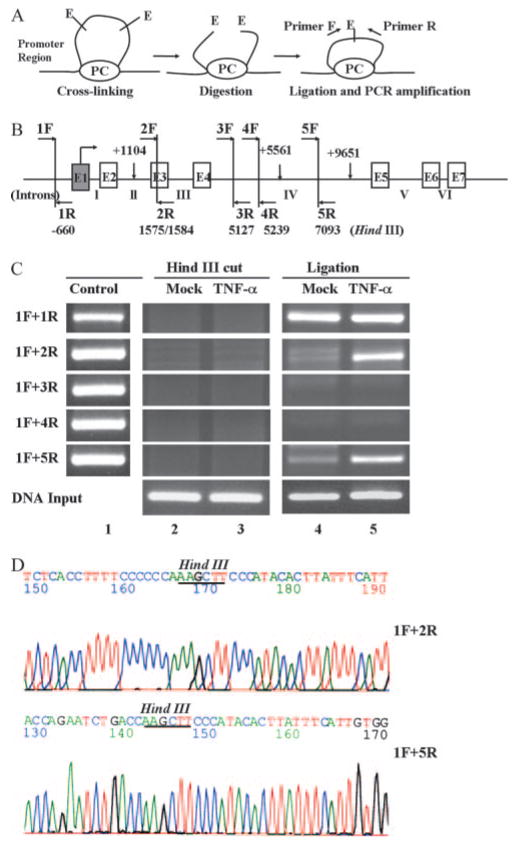FIGURE 8.
3C analysis of interaction between the promoter and the downstream human FcRn gene. A, Schematic representation of the 3C technology in analyzing human FcRn gene regulation. Chromatin from formaldehyde-fixed cells was digested with a restriction enzyme (E) and diluted for “intramolecular” ligation. Purified DNA fragments were assayed by PCR. PC, Protein complex ; F and R, forward and reverse primer, respectively. B, Locations of HindIII sites and PCR primers in the 15-kb FcRn gene are shown. Positions of the six HindIII restriction sites (perpendicular bars) from the transcriptional start site of the FcRn gene are indicated. HindIII sites (1575/1584) are spaced by only 9 bp and are considered as one site in our assay. Arrows in the HindIII fragments represent the primers used. Exons are shown as boxes and intron numbers are shown as roman numerals. C, The 3C assay. THP-1 cells were mock treated (lanes 2 and 4) or stimulated by TNF-α (50 ng/ml) for 20 min (lanes 3 and 5). Chromatin material was cross-linked and digested with excessive amounts of HindIII, ligated, and amplified by PCR. Primer 1F was the anchor primer, and the others amplified from 5′ to 3′. In lane 1 random ligation control templates were generated by amplifying the genomic DNA fragment with primers that amplify across the HindIII sites. Equimolar amounts of five different PCR products were mixed and digested with HindIII overnight at 37°C. Ligated DNA was used to generate control PCR products by using a combination of the primer pairs listed in Table II to monitor the efficiency of ligation. HindIII-digested chromosomal DNA was used as template for PCR to examine the efficiency of HindIII digestion (lanes 2 and 3). Ligated templates after dilution were used to PCR amplify after HindIII digestion and ligation (lanes 4 and 5). Input DNA was used as an internal control for PCR. D, Sequence analysis of PCR products from 3C analysis. PCR products were sequenced to confirm the fidelity of HindIII digestion and ligation. The HindIII sites were underlined in ligated products.

